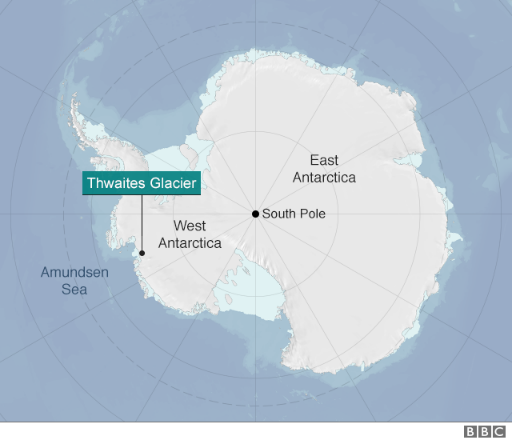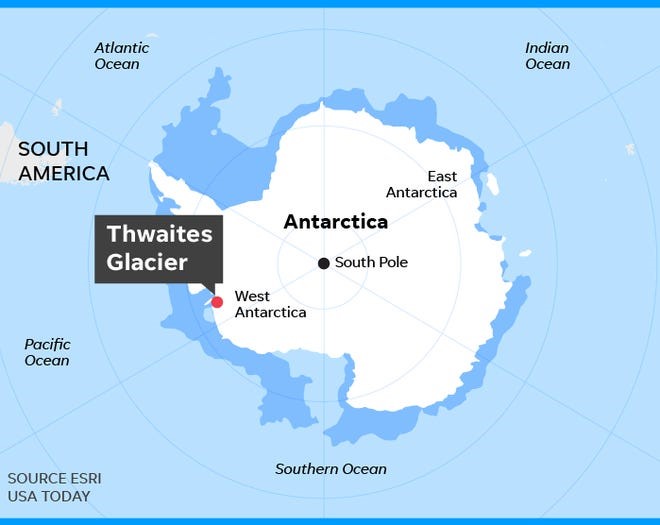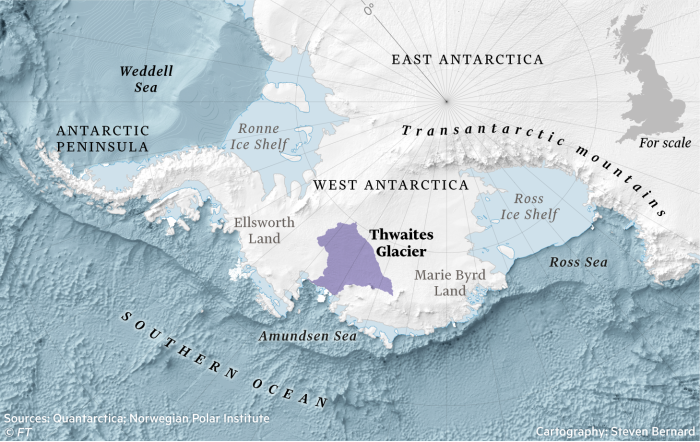Description

Disclaimer: Copyright infringement not intended.
Context
- The implications of the collapse of Thwaites Glacier are immense and is likely to rewrite both the history and geography of all living beings.
Thwaites Glacier
- Thwaites Glacier, nicknamed the Doomsday Glacier, is a broad and vast Antarctic glacier flowing into Pine Island Bay, part of the Amundsen Sea, east of Mount Murphy, on the Walgreen Coast of Marie Byrd Land.
- Thwaites Glacier is closely monitored for its potential to raise sea levels.
- Along with the Pine Island Glacier, it has been described as part of the "weak underbelly" of the West Antarctic Ice Sheet, because of its apparent vulnerability to significant retreat.
- It’s called the Doomsday Glacier because it is 120 km wide at its widest point, fast-moving, and melting rapidly over time, as per reports. It contains enough water to increase the global sea level by more than half a metre due to its size (1.9 lakh square kilometres.


Importance of Doomsday Glacier and Concerns
- Thwaites is a frozen river of ice approximately the size of Great Britain. It already contributes around 4% of the global sea-level rise.
- Since 2000, the glacier has had a net loss of more than 1000 billion tons of ice and this has increased steadily over the last three decades.
- The speed of its flow has doubled in 30 years, meaning twice as much ice is being spewed into the ocean as in the 1990s.
- Thwaites glacier, the widest in the world at 80 miles wide, is held back by a floating platform of ice called an ice shelf, which restrains the glacier and makes it flow less quickly. But scientists have just confirmed that this ice shelf is becoming rapidly destabilised. The eastern ice shelf now has cracks criss-crossing its surface, and could collapse within ten years, according to Oregon State University.
- There is a development of cracks and crevasses on the Thwaites ice shelf. These indicate that it is being structurally weakened. This damage can have a reinforcing feedback effect because cracking and fracturing can promote further weakening, priming the ice shelf for disintegration.
- Without its ice shelf, Thwaites glacier would discharge all its ice into the ocean over the following decades to centuries.
- In an event of its total collapse, its weight will simply add to that of the ocean, leading to unprecedented sea-level rise.
- A 3-metre rise in sea levels would have a significant impact on low-lying areas and coastal cities worldwide. Some of the countries that would be particularly vulnerable to this include Bangladesh, the Maldives, the Netherlands and parts of the United States such as Florida and Louisiana. However, the effects would not be limited to these areas and would be felt globally.
- Experts estimate that if the Thwaites collapsed, global sea level would rise by roughly 10 feet.
- While it could take hundreds or thousands of years, the ice shelf could dissolve considerably sooner, causing the glacier to retreat in an unstable and potentially irreversible manner.
This highlights the urgent need for global action to combat climate change and prevent catastrophic consequences like those that may result from the collapse of Thwaites Glacier.
|
PRACTICE QUESTION
Q. What do you understand by the term Doomsday Glacier? It is closely monitored for its potential to raise sea levels. Elucidate.
|

https://www.downtoearth.org.in/blog/climate-change/why-so-few-people-are-worried-about-thwaites-89045














